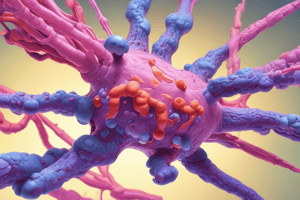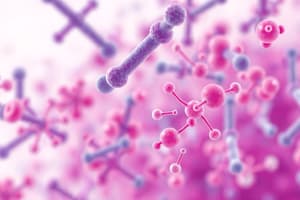Podcast
Questions and Answers
What is the primary purpose of the 'CD' system in immunology?
What is the primary purpose of the 'CD' system in immunology?
- To detect the presence of antibodies in a sample
- To measure the intensity of immune responses
- To differentiate between naive and activated B cells
- To classify and identify immune cells based on their surface markers (correct)
What is the function of the B cell receptor (BCR) in naive B cells?
What is the function of the B cell receptor (BCR) in naive B cells?
- To produce IgG antibodies
- To recognize and bind to antigens (correct)
- To provide T cell help
- To differentiate between different types of immune cells
What is the relationship between CD3 and CD14 markers on immune cells?
What is the relationship between CD3 and CD14 markers on immune cells?
- Both CD3 and CD14 are specific to T cells and monocytes
- CD3 is specific to B cells and CD14 is specific to monocytes
- CD3 is specific to T cells and CD14 is specific to monocytes (correct)
- CD3 is specific to monocytes and CD14 is specific to T cells
What is the result of a B cell's encounter with an antigen and T cell help?
What is the result of a B cell's encounter with an antigen and T cell help?
What is the purpose of using antibodies in flow cytometry?
What is the purpose of using antibodies in flow cytometry?
What is the significance of the 1982 meeting in Paris regarding the 'CD' system?
What is the significance of the 1982 meeting in Paris regarding the 'CD' system?
What is the primary function of the Constant Region of an antibody?
What is the primary function of the Constant Region of an antibody?
Which of the following techniques is used to detect secreted soluble products such as cytokines?
Which of the following techniques is used to detect secreted soluble products such as cytokines?
What is the term for the process by which antibodies change from one class to another?
What is the term for the process by which antibodies change from one class to another?
Which of the following is NOT a characteristic of flow cytometry?
Which of the following is NOT a characteristic of flow cytometry?
What is the term for the use of antibodies specific for cell surface markers on immune cells to help identify and analyze cells?
What is the term for the use of antibodies specific for cell surface markers on immune cells to help identify and analyze cells?
What is the advantage of using fluorophores with different excitation/emission profiles in flow cytometry?
What is the advantage of using fluorophores with different excitation/emission profiles in flow cytometry?
The constant region of an antibody is responsible for antigen binding.
The constant region of an antibody is responsible for antigen binding.
Immunoprecipitation is a technique used to detect cell surface molecules.
Immunoprecipitation is a technique used to detect cell surface molecules.
Streptavidin-HRP ELISA is a type of flow cytometry technique.
Streptavidin-HRP ELISA is a type of flow cytometry technique.
Monoclonal antibodies are produced from a pool of B cells specific for different epitopes of the same antigen.
Monoclonal antibodies are produced from a pool of B cells specific for different epitopes of the same antigen.
Cell size and granularity are detected by the laser light source in flow cytometry.
Cell size and granularity are detected by the laser light source in flow cytometry.
Flow cytometry can only measure one cell parameter at a time.
Flow cytometry can only measure one cell parameter at a time.
The 'CD' system was established in 1992.
The 'CD' system was established in 1992.
CD3 is a marker associated with B cells.
CD3 is a marker associated with B cells.
Monocytes and T cells both express CD14.
Monocytes and T cells both express CD14.
Antibodies are used to detect the presence of CD molecules on immune cells.
Antibodies are used to detect the presence of CD molecules on immune cells.
Naive B cells do not express antibodies on their surface.
Naive B cells do not express antibodies on their surface.
The 'CD' system is used to classify and identify immune cells.
The 'CD' system is used to classify and identify immune cells.
Flashcards are hidden until you start studying
Study Notes
- The cells of the immune system express molecules on the surface, many of which are functional components of immune cells, and these are called MARKERS, usually on the surface of the cell but can be expressed internally.
- In 1982, a group of scientists established the 'CD' system (Cluster of Differentiation) for naming these markers, and now there are over 370 CD molecules.
- Not all markers/CD molecules are specific for one cell type, some may be expressed by a number of different cells.
- Monocyte, T cell, and B cell markers include CD3, CD19, CD20, and CD14, which can be used to identify and classify these cells.
- Antibodies can detect the presence of these markers, and naïve B cells express antibodies/membrane Immunoglobulin (IgM and IgD) as part of the surface B cell receptor (BCR).
- Each B cell recognizes a different antigen, and when the BCR encounters antigen (with T cell help), they secrete IgM antibodies against the antigen.
- Later in the immune response, the same antibody variable region may be expressed in IgA, IgG, or IgE antibody classes, known as 'class switching'.
- Antibody classes can be further divided into subclasses, such as IgG1, 2a, 2b, and 3 in mice and IgG1, 2, 3, and 4 in humans, also called 'isotypes'.
- The structure of antibodies varies slightly between isotypes, with the Constant Region responsible for Effector Function (binding FcRs, activation of complement).
- Commercial Antibody preparations can be produced from one specific B cell (monoclonal Ab: MAb) or from a pool of B cells specific for different epitopes of the same antigen (polyclonal Ab).
- Antibodies can be tagged with fluorescent markers, Enzymes, or Radioactive isotopes and used on cells, soluble/secreted/biological products, and tissues.
- Antibody detection of cell surface (or internal) molecules can be used to identify/count cells, purify cells/tissues/secreted products, examine cellular activation/differentiation status, and examine pathology and expression of abnormalities.
- Techniques that use Antibodies include Affinity purification, Immunoprecipitation, ELISPOT, Immunofluorescence, Histology (immunohistochemistry), ELISA, and Flow cytometry.
- Flow cytometry uses the light scattering properties of single cells in suspension in conjunction with laser-excited fluorescence from surface marker-specific Antibodies with fluorescent tags (fluorophores) to detect expression of surface or internal markers and cellular products.
- Key features of Flow cytometry include hydrodynamic or acoustic focussing of a single cell suspension, cell size and granularity detection by Sheath fluid light scattering patterns, and the ability to 'stain' or 'label' cells for specific markers with fluorescently tagged antibodies or dyes.
- Fluorophores are excited by a laser and emit fluorescence at a longer wavelength, which is filtered, quantified, and displayed/stored by the software.
- Multiple, simultaneous measurements can be made on the same cell using different fluorophores with different excitation/emission profiles.
- Flow cytometry allows for the measurement of large numbers of cells quickly and accurately, including rare cell types.
Studying That Suits You
Use AI to generate personalized quizzes and flashcards to suit your learning preferences.



